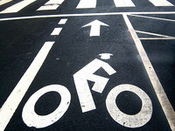Study says bike lanes really work
Are bike lanes a good idea or bad? On the one hand, they let cyclists ride in the road without blocking cars that might get impatient, honk, and even drive into cyclists. They clearly delineate that this space is for cycling, and make cyclists feel more comfortable. On the other hand, cars and trucks often don’t expect cyclists, and turn across the lane without looking, sometimes creating tragedy. Drivers often block the lanes. Is it better for bikes to drive in the regular lane, or on dedicated bike lanes?
Portland researcher Jennifer Dill believes bike lanes are better, and has hard numbers to back it up. According to Dill’s survey, which tracked 164 bicyclists for a week via GPS, most cyclists go out of their way to use bike lanes. They used the lanes for 51% of trips on the lanes even though only 8% of roads have such lanes.
Of course, just because people choose to use the lanes doesn’t prove they are better or safer. But Dill found a psychological effect as well with a big gender gap. According to the article, “Women are far more reluctant than men to ride a bicycle in heavy motor vehicle traffic,” with 52% of women citing traffic as an obstacle to more cycling, while only 34% of men wouldn’t ride because of traffic.
Whether collisions in bike lanes are more numerous or worse than collisions outside bike lanes, there’s clear evidence that lanes make more people feel safer riding. And the more people ride, the safer it is, because drivers become accustomed to seeing and avoiding cyclists. This study won’t settle the ongoing debate, but it provides one more piece of evidence that more bike lanes are better for everyone.

